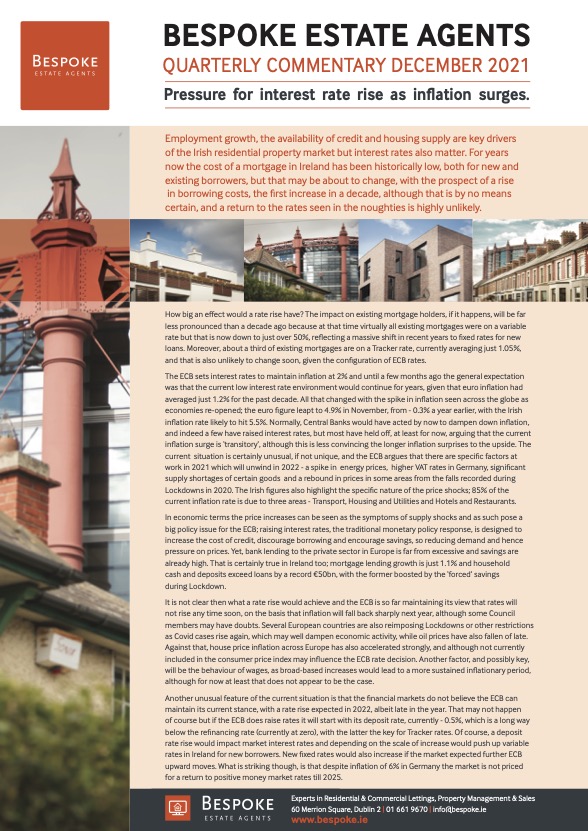Pressure for interest rate rise as inflation surges
Employment growth, the availability of credit and housing supply are key drivers of the Irish residential property market but interest rates also matter. For years now the cost of a mortgage in Ireland has been historically low, both for new and existing borrowers, but that may be about to change, with the prospect of a rise in borrowing costs, the first increase in a decade, although that is by no means certain, and a return to the rates seen in the noughties is highly unlikely.
How big an effect would a rate rise have? The impact on existing mortgage holders, if it happens, will be far less pronounced than a decade ago because at that time virtually all existing mortgages were on a variable rate but that is now down to just over 50%, reflecting a massive shift in recent years to fixed rates for new loans. Moreover, about a third of existing mortgages are on a Tracker rate, currently averaging just 1.05%, and that is also unlikely to change soon, given the configuration of ECB rates.
The ECB sets interest rates to maintain inflation at 2% and until a few months ago the general expectation was that the current low interest rate environment would continue for years, given that euro inflation had averaged just 1.2% for the past decade. All that changed with the spike in inflation seen across the globe as economies re-opened; the euro figure leapt to 4.9% in November, from – 0.3% a year earlier, with the Irish inflation rate likely to hit 5.5%. Normally, Central Banks would have acted by now to dampen down inflation, and indeed a few have raised interest rates, but most have held off, at least for now, arguing that the current inflation surge is ‘transitory’, although this is less convincing the longer inflation surprises to the upside. The current situation is certainly unusual, if not unique, and the ECB argues that there are specific factors at work in 2021 which will unwind in 2022 – a spike in energy prices, higher VAT rates in Germany, significant supply shortages of certain goods and a rebound in prices in some areas from the falls recorded during Lockdowns in 2020. The Irish figures also highlight the specific nature of the price shocks; 85% of the current inflation rate is due to three areas – Transport, Housing and Utilities and Hotels and Restaurants.
In economic terms the price increases can be seen as the symptoms of supply shocks and as such pose a big policy issue for the ECB; raising interest rates, the traditional monetary policy response, is designed to increase the cost of credit, discourage borrowing and encourage savings, so reducing demand and hence pressure on prices. Yet, bank lending to the private sector in Europe is far from excessive and savings are already high. That is certainly true in Ireland too; mortgage lending growth is just 1.1% and household cash and deposits exceed loans by a record €50bn, with the former boosted by the ‘forced’ savings during Lockdown.
It is not clear then what a rate rise would achieve and the ECB is so far maintaining its view that rates will
not rise any time soon, on the basis that inflation will fall back sharply next year, although some Council members may have doubts. Several European countries are also reimposing Lockdowns or other restrictions as Covid cases rise again, which may well dampen economic activity, while oil prices have also fallen of late. Against that, house price inflation across Europe has also accelerated strongly, and although not currently included in the consumer price index may influence the ECB rate decision. Another factor, and possibly key, will be the behaviour of wages, as broad-based increases would lead to a more sustained inflationary period, although for now at least that does not appear to be the case.
Another unusual feature of the current situation is that the financial markets do not believe the ECB can maintain its current stance, with a rate rise expected in 2022, albeit late in the year. That may not happen of course but if the ECB does raise rates it will start with its deposit rate, currently – 0.5%, which is a long way below the refinancing rate (currently at zero), with the latter the key for Tracker rates. Of course, a deposit rate rise would impact market interest rates and depending on the scale of increase would push up variable rates in Ireland for new borrowers. New fixed rates would also increase if the market expected further ECB upward moves. What is striking though, is that despite inflation of 6% in Germany the market is not priced for a return to positive money market rates till 2025.




